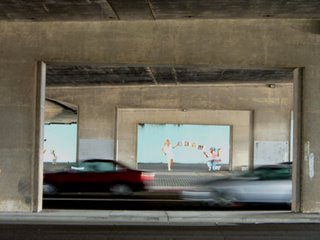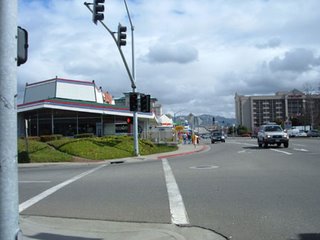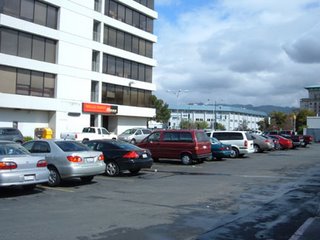Walking To Lunch In Emeryville, California
These pictures show my walk to lunch when I worked in Emeryville, California. Most Americans live in the midst of this sort of cityscape but don't pay much attention to it because they drive everywhere. I am stubborn enough to walk to lunch, even in a city where everyone drives, so I get a good, long look at how ugly it is.
In order to live in cities like this, we are willing to change the world's climate and to go to war for oil.
 Walking out of my office, the first thing I see is the freeway and Frontage Road. My goal is the building right across the freeway with the red roof and the signs that say "Public Market" and "Borders Books."
Walking out of my office, the first thing I see is the freeway and Frontage Road. My goal is the building right across the freeway with the red roof and the signs that say "Public Market" and "Borders Books."
 I start by walking past the Holiday Inn parking lot and the Shell Station. Believe it or not, this street is part of the San Francisco Bay Trail, which is supposed to give people the opportunity to walk near the bay and enjoy its beauty.
I start by walking past the Holiday Inn parking lot and the Shell Station. Believe it or not, this street is part of the San Francisco Bay Trail, which is supposed to give people the opportunity to walk near the bay and enjoy its beauty.
 Be careful crossing, because cars exiting from the freeway usually don't stop for pedestrians in the crosswalk before making the right turn that is not controlled by a stop light.
Be careful crossing, because cars exiting from the freeway usually don't stop for pedestrians in the crosswalk before making the right turn that is not controlled by a stop light.
 Walking under the freeway, I see the public art that the city of Emeryville has put there. Here we see two figures holding a sign that says "Emeryville." It is a fitting gateway to the city.
Walking under the freeway, I see the public art that the city of Emeryville has put there. Here we see two figures holding a sign that says "Emeryville." It is a fitting gateway to the city.
 Then I cut through the Denny's landscaping. Note that pedestrians have beaten a path through this landscaping, a sign that the traffic engineers who designed the street system did not think about how it would work for pedestrians.
Then I cut through the Denny's landscaping. Note that pedestrians have beaten a path through this landscaping, a sign that the traffic engineers who designed the street system did not think about how it would work for pedestrians.
 Then I cut through the Denny's parking lot.
Then I cut through the Denny's parking lot.
 Then I cut through the parking lot of the Wells Fargo building. In the background, you can see the EmeryBay Cafe, which has a couple of tables in front where people can sit and look at the parking lot while they eat.
Then I cut through the parking lot of the Wells Fargo building. In the background, you can see the EmeryBay Cafe, which has a couple of tables in front where people can sit and look at the parking lot while they eat.
 There is a long wait to cross at this intersection, where the lights are timed for automobile traffic.
There is a long wait to cross at this intersection, where the lights are timed for automobile traffic.
 Then I cut through the parking lot of a company named Innovative Interfaces. They obviously did not design a very user-friendly interface between their office building and the public realm.
Then I cut through the parking lot of a company named Innovative Interfaces. They obviously did not design a very user-friendly interface between their office building and the public realm.
 Then I cut through the Public Market parking lot.
Then I cut through the Public Market parking lot.
 Finally, I reach the so-called Emeryville Public Market, with its Borders Bookstore. It is a small island of pedestrians in an ocean of cars, and it has a food court where I buy lunch.
Finally, I reach the so-called Emeryville Public Market, with its Borders Bookstore. It is a small island of pedestrians in an ocean of cars, and it has a food court where I buy lunch.
In order to live in cities like this, we are willing to change the world's climate and to go to war for oil.
 Walking out of my office, the first thing I see is the freeway and Frontage Road. My goal is the building right across the freeway with the red roof and the signs that say "Public Market" and "Borders Books."
Walking out of my office, the first thing I see is the freeway and Frontage Road. My goal is the building right across the freeway with the red roof and the signs that say "Public Market" and "Borders Books." I start by walking past the Holiday Inn parking lot and the Shell Station. Believe it or not, this street is part of the San Francisco Bay Trail, which is supposed to give people the opportunity to walk near the bay and enjoy its beauty.
I start by walking past the Holiday Inn parking lot and the Shell Station. Believe it or not, this street is part of the San Francisco Bay Trail, which is supposed to give people the opportunity to walk near the bay and enjoy its beauty. Be careful crossing, because cars exiting from the freeway usually don't stop for pedestrians in the crosswalk before making the right turn that is not controlled by a stop light.
Be careful crossing, because cars exiting from the freeway usually don't stop for pedestrians in the crosswalk before making the right turn that is not controlled by a stop light. Walking under the freeway, I see the public art that the city of Emeryville has put there. Here we see two figures holding a sign that says "Emeryville." It is a fitting gateway to the city.
Walking under the freeway, I see the public art that the city of Emeryville has put there. Here we see two figures holding a sign that says "Emeryville." It is a fitting gateway to the city. Then I cut through the Denny's landscaping. Note that pedestrians have beaten a path through this landscaping, a sign that the traffic engineers who designed the street system did not think about how it would work for pedestrians.
Then I cut through the Denny's landscaping. Note that pedestrians have beaten a path through this landscaping, a sign that the traffic engineers who designed the street system did not think about how it would work for pedestrians. Then I cut through the Denny's parking lot.
Then I cut through the Denny's parking lot. Then I cut through the parking lot of the Wells Fargo building. In the background, you can see the EmeryBay Cafe, which has a couple of tables in front where people can sit and look at the parking lot while they eat.
Then I cut through the parking lot of the Wells Fargo building. In the background, you can see the EmeryBay Cafe, which has a couple of tables in front where people can sit and look at the parking lot while they eat. There is a long wait to cross at this intersection, where the lights are timed for automobile traffic.
There is a long wait to cross at this intersection, where the lights are timed for automobile traffic. Then I cut through the parking lot of a company named Innovative Interfaces. They obviously did not design a very user-friendly interface between their office building and the public realm.
Then I cut through the parking lot of a company named Innovative Interfaces. They obviously did not design a very user-friendly interface between their office building and the public realm. Then I cut through the Public Market parking lot.
Then I cut through the Public Market parking lot. Finally, I reach the so-called Emeryville Public Market, with its Borders Bookstore. It is a small island of pedestrians in an ocean of cars, and it has a food court where I buy lunch.
Finally, I reach the so-called Emeryville Public Market, with its Borders Bookstore. It is a small island of pedestrians in an ocean of cars, and it has a food court where I buy lunch.
